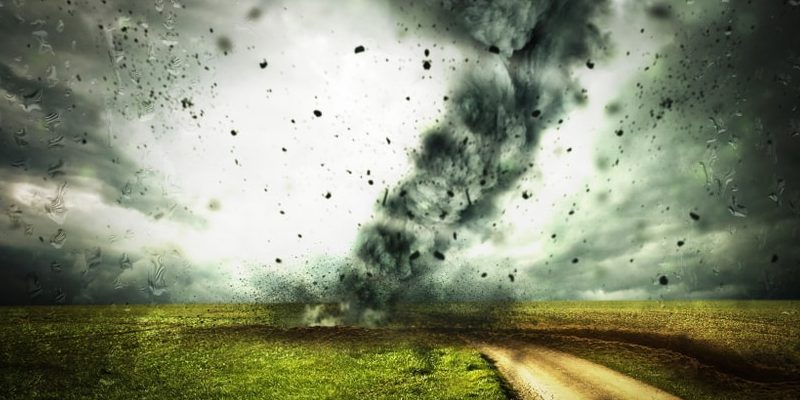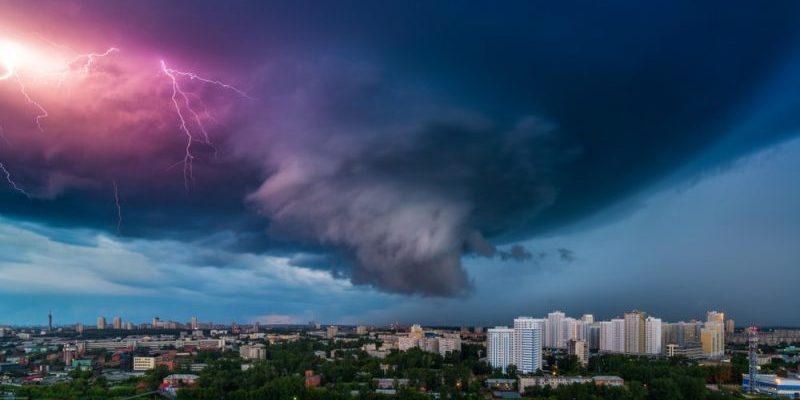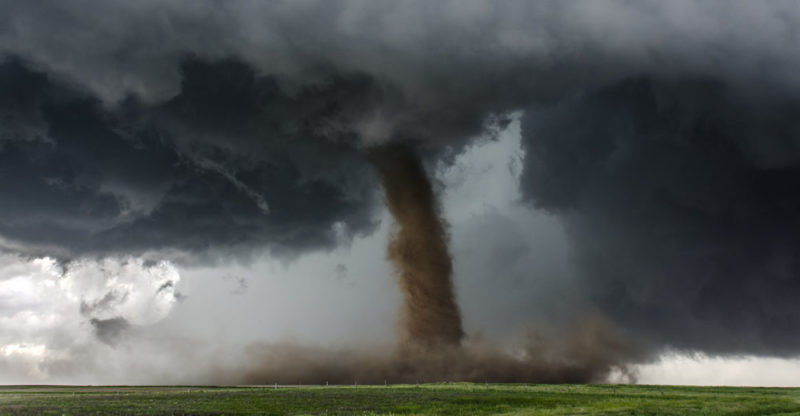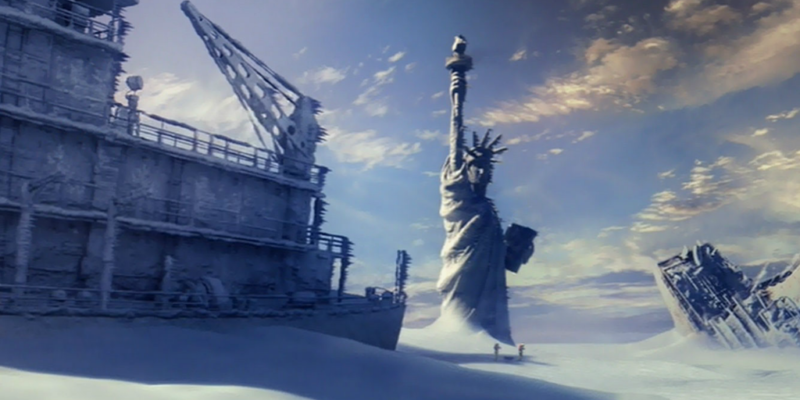We explain what tornadoes are, how they form and what their consequences are. In addition, its general characteristics and classification.
What is a tornado?
A tornado is a cyclonic atmospheric phenomenon, of short duration and extension but great intensity , in which an air mass rotates on an axis at high angular velocity, having its lower end on the earth's surface and the upper end generally in contact , with a cumulonimbus cloud.
Tornadoes can come in different shapes and sizes , but they generally resemble a rotating tube of clouds, funneling from the sky to the ground and usually surrounded by a cloud of debris and dust, since its winds are so intense that they start and pick up everything in their path. They usually last between a few seconds and an hour.
Those who are in charge of anticipating and alerting about these climatic phenomena are called “tornado hunters”.
How a tornado form?
All tornadoes come from a storm cloud (supercellular or non-supercellular), a product of warm and humid air that is forced to rise, for example, when faced with a cold front.
This must coincide with a vertical wind shear , that is, a wind that gains energy by ascending into the atmosphere along six to eight kilometers in height.
Depending, then, on the type of storm cloud, we will have a really destructive tornado, or a more tame one , whether or not a mesocyclone is formed : an intense circulatory movement of air masses.
Types of tornadoes

In principle, we can talk about two types of tornadoes, based on the type of storm cloud from which they formed: supercellular or non-supercellular .
The former are the most violent but unlikely of all and are easily identified because the base of the cloud rotates along with the cyclone.
Other types of tornadoes according to their nature and structure are:
- Multiple vortex tornado. These are two or more columns of air revolving around a common axis, giving rise to various vortices or "tips" of the cyclone, usually smaller and around the passage of the main axis.
- Satellite tornado. Often confused with the previous case, it is about two tornadoes (one large and the other small) that meet or form very close, so that the smaller one oscillates or orbits the larger one, as if it were a satellite (hence your name).
- Waterspout. Also called a water hose , it is a tornado over the sea or a large body of water. They can be tornadoes formed directly on the water or that simply hit it, but they can be faster, more intense and of longer duration than on land.
- Land barrage. This is the name given to tornadoes on land that do not have a mesocyclone, which makes them much weaker than cyclonic tornadoes, although not for that reason they are harmless. They usually create a sheet of dust around them.
Causes of a tornado
The cause of a tornado has to do with the meeting of two air masses of different temperatures , which, trapped in a stormy climate , oscillate around a common axis.
These air masses push each other and gain with each greater turn and greater angular velocity , until they build a true spiral of wind that sucks everything in its path and lifts it up into the atmosphere or sends it flying in any direction like a projectile. .
Aftermath of a tornado

The consequences of tornadoes are usually more or less devastating , depending on the energy that the cyclone acquires and how long it lasts.
They can generally uproot trees, roofs, lift smaller objects and throw them miles at high and dangerous speeds.
In addition, tornadoes are usually accompanied by a storm , that is, heavy rains , hail and hurricane-force winds.
It can serve you: Hurricane .
Life cycle of a tornado
The usual life cycle of tornadoes involves the following phases, which are usually more or less brief:
- Training. Tornadoes generally originate in atmospheric mesocyclones, rotating air masses in the atmosphere (2 to 10 km wide) that eventually coincide with an ascending column of warm air, forcing cold air to descend, in the manner of an invisible whirlpool that, when it touches the ground and tears objects, leaves and dust, acquires color.
- Maturity. Once the cyclone is formed, it grows to its maximum size in minutes or an hour, unleashing its energy and producing the most disasters of its existence, before the flow of hot air begins to stop and the cycle is destabilized.
- Dissipation. In the tornado's final stage, the interruption of the air supply weakens the vortex and makes it rope-thin, before losing even more energy and dissipating. This last process also weakens the mesocyclone and can lead to the formation of other similar ones in other areas.
Where do tornadoes form?

Tornadoes have been observed on all continents except Antarctica , but they mostly occur in the region of the United States known as “Tornado Alley,” in the Northern Hemisphere, and in the “Corridor of Tornadoes” that encompasses in the southern hemisphere to the northwest, center and northeast of Argentina , southwest of Brazil , south of Paraguay and the whole of Uruguay .
It is also common to see them in south-central Asia , South Africa or Southeast Australia and New Zealand, and to a lesser extent in Southeast and Northwest Europe.
What should be done in the event of a tornado?
Forecasts in the event of a tornado indicate:
- Seclude ourselves in the room farthest from the windows that we can find, in a building that is as solid as possible. We must take companions, children and pets with us.
- If we are not at home, it is advisable to take shelter and avoid large open spaces such as classrooms, gyms or auditoriums.
- If we are behind the wheel, the ideal is to drive to the nearest shelter and not try to go through the tornado.
- If we are in the open, it is advisable to look for a ditch or a ravine to wait for the tornado to pass, always covering our heads to avoid projectiles.
Tornado intensity

Most tornadoes have winds that reach speeds of between 65 and 180 kmph (450 kmph cases have been seen), can reach up to 75 meters wide (some 2 km wide have been witnessed) and usually travel a few kilometers before fading and fading.
The intensity of tornadoes is measured on various scales, generally based on the amount of damage it is capable of causing. Thus, there are the Fujita-Pearson Scale, the Improved Fujita or the TORRO scale .
Worst tornadoes in history
The most disastrous and dangerous tornadoes in history have been:
- The United States Tri-State tornado of March 18, 1925, probably classified as F5 (the Fujita scale did not yet exist), traveled 325 km in about 3.5 hours at a travel speed of 117kmph. It is the record tornado in these measurements in the entire world.
- The Dalautpur-Saturia tornado in Bangladesh on April 26, 1989, considered the deadliest in history, killed approximately 1,300 people .
Tornadoes in the movies

Tornadoes are a fearsome force of nature that has inspired numerous films, especially in the Hollywood industry, such as: Hurricane (1979), Twister (1996), Perfect Storm (2000) , The Day After Tomorrow (2004) and Eye Hurricane (2012), as well as the unlikely Sharknado (2013) and its aftermath, in which a cyclone fills with hungry live sharks.
The above content published at Collaborative Research Group is for informational and educational purposes only and has been developed by referring reliable sources and recommendations from technology experts. We do not have any contact with official entities nor do we intend to replace the information that they emit.
MA student of the TransAtlantic Masters program at UNC-Chapel Hill. Political Science with a focus on European Studies. Expressed ideas are open to revision. He not only covers Technical articles but also has skills in the fields of SEO, graphics, web development and coding. .
Leave a reply
Your email address will not be published. Required fields are marked *Recent post

Sport: What Is It, Types, Risks, Features, Characteristics and Examples

Dogs: Emergence, Features, Characteristics, Feeding and Breeds

Story: Definition, Elements, Structure, Features and Characteristics

